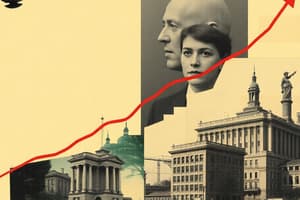Podcast
Questions and Answers
What does the Solow Residual measure?
What does the Solow Residual measure?
- The relationship between labor and physical capital
- The output of an economy
- The difference between actual and potential economic growth (correct)
- The difference between capital accumulation and savings
Who originally developed the Solow Growth Model?
Who originally developed the Solow Growth Model?
- Robert Solow and Trevor Swan (correct)
- Adam Smith
- Wassily Leontief
- Harrod and Domar
What is the Solow Production Function?
What is the Solow Production Function?
- An extension of the Solow Growth Model to include technological change
- A measure of the difference between actual and potential economic growth
- A measure of capital accumulation in an economy
- A formula describing the relationship between labor and physical capital, and the output of an economy (correct)
In the Solow Growth Model, what determines the rate of capital accumulation?
In the Solow Growth Model, what determines the rate of capital accumulation?
What does the Solow's Neoclassical Growth Model include that the original Solow Growth Model does not?
What does the Solow's Neoclassical Growth Model include that the original Solow Growth Model does not?
What kind of economic growth model is the Solow Growth Model?
What kind of economic growth model is the Solow Growth Model?
What are the constant returns to scale in the Solow Growth Model?
What are the constant returns to scale in the Solow Growth Model?
What is represented by $Y$ in the Solow's Neoclassical Growth Model equation $Y = AK^{1-oldsymbol{ ext{α}}}L^oldsymbol{ ext{α}}$?
What is represented by $Y$ in the Solow's Neoclassical Growth Model equation $Y = AK^{1-oldsymbol{ ext{α}}}L^oldsymbol{ ext{α}}$?
What do the inputs $K$ and $L$ represent in the equation $Y = AK^{1-oldsymbol{ ext{α}}}L^oldsymbol{ ext{α}}$?
What do the inputs $K$ and $L$ represent in the equation $Y = AK^{1-oldsymbol{ ext{α}}}L^oldsymbol{ ext{α}}$?
Flashcards are hidden until you start studying
Study Notes
The Solow Growth Model: Understanding the Equations
The Solow Growth Model, also known as the Harrod-Domar model or Solow-Swan model, is a neoclassical economic growth model that attempts to explain the long-term growth of an economy with constant returns to scale[1,2]. It was originally developed by economists Robert Solow and Trevor Swan in the 1950s and later refined by Wassily Leontief. The model focuses on the relationship between savings, capital accumulation, and economic growth.
Key Equations
- Solow Residual (SR): The Solow Residual is a measure of the difference between the actual growth rate of an economy and the growth rate that would be expected if the economy were operating at its potential.
$$SR = \frac{2}{3}Y - \frac{1}{3}K$$
- Solow Production Function: The Solow Production Function is a formula that describes the relationship between the inputs of labor and physical capital, and the output of an economy.
$$Y = F(K,L)$$
- Capital Accumulation: The rate of capital accumulation in the Solow Growth Model is determined by the difference between investment and depreciation of capital.
$$\Delta K = I - D$$
- Solow's Neoclassical Growth Model: Solow's Neoclassical Growth Model is an extension of the Solow Growth Model that includes the effects of technological change on economic growth.
$$Y = AK^{1-\alpha}L^\alpha$$
- Solow's Residual: The Solow's Residual is the difference between actual growth and potential growth, and it represents the contribution of unmeasured technological progress to growth.
$$SR = Y - F(K,L)$$
These equations and formulas help to understand how the Solow Growth Model explains the long-term growth of an economy by focusing on the relationship between savings, capital accumulation, and economic growth. The model can be applied to various countries and periods to analyze their economic growth and identify potential constraints to growth.
Studying That Suits You
Use AI to generate personalized quizzes and flashcards to suit your learning preferences.




